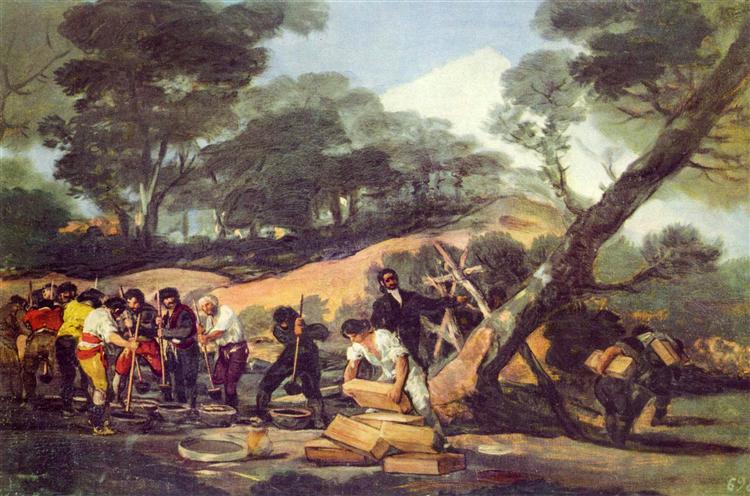Description
Francisco Goya's "Gunpowder Factory in the Sierra" (1814) is a notable example of the artist's ability to capture tense and dramatic situations, reflecting a complex social and political context. Painted in a period marked by the Spanish War of Independence, this work is set in a context of unrest and change, where daily life is intertwined with the consequences of war.
The painting depicts an industrial setting that, within, reveals a scene of fury and destruction. The depiction of the factory, with its smoking chimneys and stone structures, is surrounded by a nightmarish atmosphere that evokes a sense of impending chaos. Goya made bold use of colour and light to highlight the destructive energy emanating from this environment. Shades of grey and brown dominate the palette, accentuating the squalor of the landscape and underlining the sadness of life under the shadow of conflict.
There are no clearly defined human figures in the work, but the sense of tumultuous activity suggests the presence of workers and citizens caught up in the chaos of the huge explosion that seems to have devastated the factory. This lack of individual figures creates an anonymous atmosphere, reinforcing the idea that the tragedy affects many and not just a few, reflecting the collective experience of war and its impact on society.
Through this grim depiction, Goya becomes a visual chronicler of his time, capturing not only the impact of war on infrastructure, but also the effect of violence on human morality. His style, characterized by a mix of realism and surrealism, helps to understand the brutality of the moment he is portraying. This approach is palpable in the manifest absence of idealization: instead of glorifying war or its machinery, Goya chooses to show its devastating consequences.
The interpretation of "Fábrica de Pólvora en la Sierra" is enriched when we consider the career and artistic evolution of Goya, who witnessed profound social and political changes in his homeland. His early works, charged with a classicism influenced by his upbringing, evolved towards a more critical and personal approach. This shift was accentuated by the experiences he lived through during political upheavals and crises, which led him to explore themes of madness, war and human pain. In this sense, the work can be seen as a manifestation of the sombre naturalism that characterizes his later years.
The particularity of this painting lies in its ability to resonate with the contemporary viewer, inviting us to reflect not only on a specific period of Spanish history, but also on the relationship between humanity and the forces that destroy it. Ultimately, "Fábrica de Pólvora en la Sierra" is a testament to Goya both as an artist and as a member of a society in crisis, a work that continues to speak to us from the past with unusual clarity and desperation.
KUADROS ©, a famous painting on your wall.
Hand-made oil painting reproductions, with the quality of professional artists and the distinctive seal of KUADROS ©.
Painting reproduction service with satisfaction guarantee. If you are not completely satisfied with the replica of your painting, we will refund 100% of your money.

